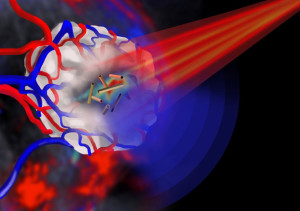
The nanotubes can be tumor-targeted and have a central ‘hollow’ core that can be loaded with a therapeutic payload.
Image: Jing Claussen (iThera Medical, Germany)
Gold nanotubes have multiple applications in fighting cancer, including internal nanoprobes for high-resolution imaging and drug delivery vehicles. With new research from the University of Leeds, we’re discovering that these gold nanotubes may also be able to give doctors the chance to treat cancer as soon as they spot it.
“Gold nanotubes – that is, gold nanoparticles with tubular structures that resemble tiny drinking straws – have the potential to enhance the efficacy of these conventional treatments by integrating diagnosis and therapy in one single system,” said Professor at the University of Leeds Institute for Biomedical and Clinical Science Sunjie Ye in a release.
The new study shows the first successful demonstration of biomedical use of gold nanotubes in a mouse model of human cancer. The researchers hope that these results will aid in the treatment of cancer and address the issue of high recurrence rates of tumors after surgical removal.
“When the gold nanotubes travel through the body, if light of the right frequency is shone on them they absorb the light. This light energy is converted to heat, rather like the warmth generated by the Sun on skin. Using a pulsed laser beam, we were able to rapidly raise the temperature in the vicinity of the nanotubes so that it was high enough to destroy cancer cells,” said the study’s corresponding author Professor Steve Evans in a release.
Shining a low brightness allows the nanotubes to reveal tumors. Conversely, shining a high brightness will heat the tubes enough to kill nearby tumorous cells. The shape of the tube is also convenient because it allows room for drugs, so you can deliver medicine at the same time as you are scanning.
This from University of Leeds:
In order to see the gold nanotubes in the body, the researchers used a new type of imaging technique called ‘multispectral optoacoustic tomography’ (MSOT) to detect the gold nanotubes in mice, in which gold nanotubes had been injected intravenously. It is the first biomedical application of gold nanotubes within a living organism. It was also shown that gold nanotubes were excreted from the body and therefore are unlikely to cause problems in terms of toxicity, an important consideration when developing nanoparticles for clinical use.
The research paper, “Engineering Gold Nanotubes with Controlled Length and Near-Infrared Absorption for Theranostic Applications,” can be found here.
[Sources: University of Leeds & Engadget]Check out more research on nanotubes in the Digital Library.
And if that interests you, make sure to attend the ECS 227th Meeting this May, where we’ll be featuring symposium on carbon nanostructures and devices, with an emphasis on nanotubes, fullerenes, and graphene.

